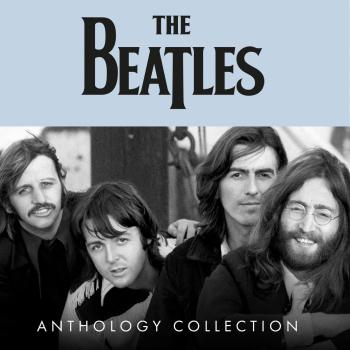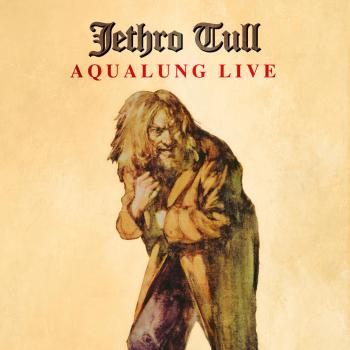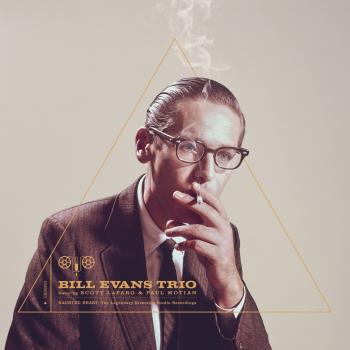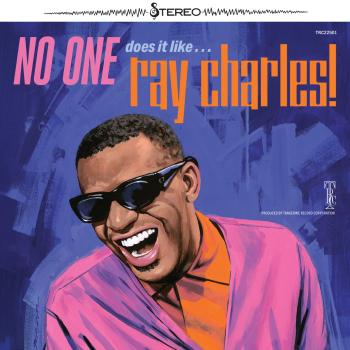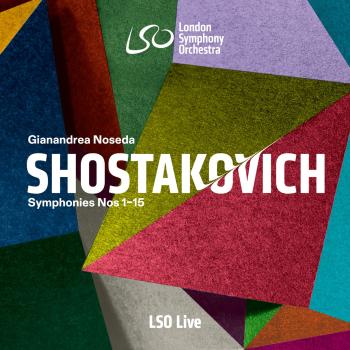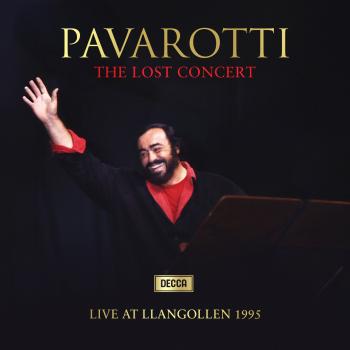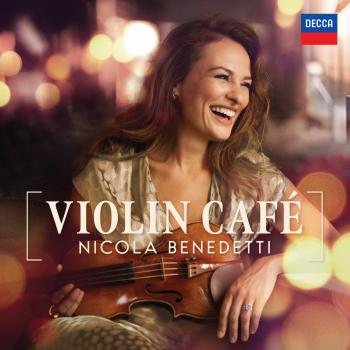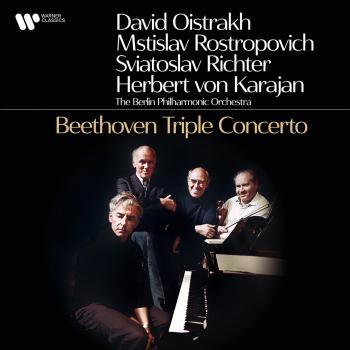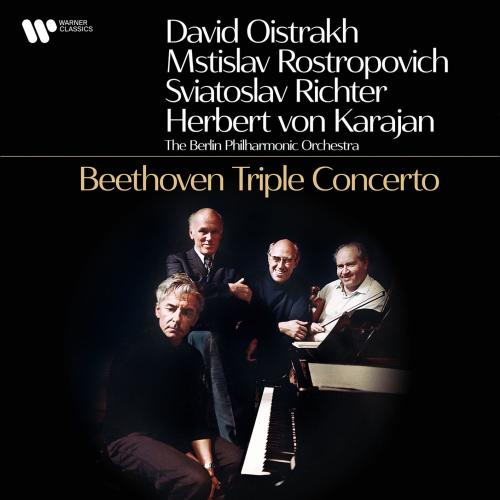
Beethoven: Triple Concerto for Violin, Cello and Piano in C Major, Op. 56 (Remastered) David Oistrakh, Mstislav Rostropovich, Sviatoslav Richter, Herbert von Karajan & The Berlin Philharmonic Orchestra
Album info
Album-Release:
1969
HRA-Release:
28.11.2025
Label: Warner Classics
Genre: Classical
Subgenre: Concertos
Composer: Ludwig van Beethoven (1770-1824)
Album including Album cover
I`m sorry!
Dear HIGHRESAUDIO Visitor,
due to territorial constraints and also different releases dates in each country you currently can`t purchase this album. We are updating our release dates twice a week. So, please feel free to check from time-to-time, if the album is available for your country.
We suggest, that you bookmark the album and use our Short List function.
Thank you for your understanding and patience.
Yours sincerely, HIGHRESAUDIO
- Ludwig van Beethoven (1770 - 1827): Triple Concerto in C Major, Op. 56:
- 1 Beethoven: Triple Concerto in C Major, Op. 56: I. Allegro 17:53
- 2 Beethoven: Triple Concerto in C Major, Op. 56: II. Largo 05:35
- 3 Beethoven: Triple Concerto in C Major, Op. 56: III. Rondo alla polacca 12:57
Info for Beethoven: Triple Concerto for Violin, Cello and Piano in C Major, Op. 56 (Remastered)
The absolutely iconic recording from Beethoven's 'Triple Concerto': a first-class cast gathering three legendary Russian soloists: violinist David Oistrakh, cellist Mstislav Rostropovich and pianist Sviatoslav Richter, under the imperial baton of Herbert von Karajan. Made in September 1969 at the Jesus-Christus-Kirche in Berlin with the Berliner Philharmoniker, this was their only collaboration on disc and the album remains on the very top versions of this work. A performance of supreme distinction and joy.
One of the most famous recordings of classical music history! In 1969, EMI pulled off the remarkable feat of bringing together the greatest soloists of their time under the baton of Herbert von Karajan to record Beethoven's Triple Concerto. Although the recording was somewhat turbulent, due in particular to the big egos of those involved, this recording stands out as one of the definitive versions of this concerto. It is now finally available on digital, and in a high-resolution remastering (made by Art & Son for our comprehensive Oistrakh edition).
EMI producer Peter Andry and audio engineer Allen Stagg made the recording at Jesus-Christus-Kirche, Berlin, in 1969. They captured a wide dynamic range, so wide, in fact, that the opening passage may tempt you to turn up the gain. Don’t. The volume soon rises startlingly, along with some solid transient impact. Instrument separation is excellent, transparency in the somewhat robustly thick midrange is nevertheless quite good, and depth and air are more than adequate.
Ludwig van Beethoven's Concerto for Violin, Cello, and Piano in C major, Op. 56, commonly known as the Triple Concerto, was composed from 1803 to 1804, or beyond, and published in 1807 by Breitkopf & Härtel. The choice of the three solo instruments effectively makes this a concerto for piano trio, and it is the only concerto Beethoven ever completed for more than one solo instrument, also being the only concerto he wrote for cello. A typical performance takes approximately thirty-seven minutes.
"Even in these days of star-studded casting on record, the line-up for this latest version of the Triple Concerto is nothing short of breathtaking. So breathtaking I was worried that my expectations would run ahead of all possible achievement. But not so. This is a marvellous performance that will clearly remain a classic for years to come" (Edward Greenfield, GRAMOPHONE, September 1970)
David Oistrakh, violin
Mstislav Rostropovich, violoncelo
Sviatoslav Richter, piano
Berlin Philharmonic Orchestra
Herbert von Karajan, condutor
Digitally remastered
David Oistrakh
(1908-1974) is considered the premiere violinist of the mid-twentieth century Soviet Union. His recorded legacy includes nearly the entire standard violin repertory up to and including Prokofiev and Bartók. His violin studies began in 1913 with Pyotr Stolyarsky. Later he officially joined Stolyarsky's class at the Odessa Conservatory, graduating in 1926 by playing Prokofiev's First Violin Concerto. Performances of the Glazunov Concerto in Odessa and Kiev in 1927, and a 1928 debut in Leningrad (Tchaikovsky Concerto) gave him the confidence to move to Moscow. He made his premiere there in early 1929, but the event went largely unnoticed. In 1934, however, after several years of patiently refining his craft, he was invited to join the Moscow Conservatory, eventually rising to the rank of full professor in 1939.
Meanwhile, David Oistrakh was gaining success on the competition circuit, winning the All-Ukrainian contest in 1930, and the All-Soviet competition three years later. In 1935 he took second prize at the Wieniawski competition. In 1937 the Soviet government sent the now veteran violinist to Brussels to compete in the International Ysaÿe Competition, where he took home first prize.
With his victory in Brussels, Soviet composers began to take notice of their young compatriot, enabling him to work closely with Miaskovsky and Khachaturian on their concertos in 1939 and 1940, respectively. In addition, his close friendship with Shostakovich led the composer to write two concertos for the instrument (the first of which Oistrakh played at his, and its, triumphant American premiere in 1955). During the 1940s David Oistrakh's active performing schedule took him across the Soviet Union but his international career had to wait until the 1950s, when the political climate had cooled enough for Soviet artists to be welcomed in the capitals of the West.
The remaining decades of his life were devoted to maintaining the highest possible standards of excellence throughout an exhausting touring schedule (he returned to the U.S. six times in the 1960s), and he began a small but successful sideline career as an orchestral conductor. His death came suddenly in Amsterdam in 1974, during a cycle of Brahms concerts in which he both played and conducted.
Throughout his career David Oistrakh was known for his honest, warm personality; he developed close friendships with many of the leading musicians of the day. His violin technique was virtually flawless, though he never allowed purely physical matters to dominate his musical performances. He always demanded of himself (and his students) that musical proficiency, intelligence, and emotion be in balance, regardless of the particular style. David Oistrakh felt that a violinist's essence was communicated through clever and subtle use of the bow, and not through overly expressive use of vibrato. To this end he developed a remarkably relaxed, flexible right arm technique, capable of producing the most delicate expressive nuances, but equally capable of generating great volume and projection.
As a teacher, David Oistrakh maintained that a teacher should do no more than necessary to help guide the student towards his or her own solutions to technical and interpretive difficulties. He rarely played during lessons, fearing that he might distract the student from developing a more individual approach, and even encouraged his students to challenge his interpretations. Perhaps the best evidence of the Oistrakh's gift for teaching is that he felt that he gained as much from the teaching experience as his students did.
This album contains no booklet.

